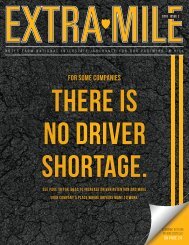ExtraMileIssue9
Create successful ePaper yourself
Turn your PDF publications into a flip-book with our unique Google optimized e-Paper software.
You can identify your strengths by identifying the areas you excel in,<br />
and then asking “why?” This is a step many companies miss. Knowing<br />
that you excel at customer retention is great. Understanding why you<br />
excel positions you to leverage those strengths in other areas.<br />
If you don’t have many specific metrics, ask your leadership team,<br />
“What are the things we do really well? What do our happiest<br />
customers say about us?”<br />
This is where the rubber really hits the road. If a company doesn’t<br />
understand what makes it great, then they run the risk of damaging<br />
their success.<br />
Targets<br />
Once your team has looked at where the company is today and what<br />
your existing strengths are, it’s time to identify your targets. Every big<br />
goal in your strategic plan can be broken down into smaller targets.<br />
To identify them, look at your goals and look at where you are now.<br />
Where are the gaps? What do you need to change about your business,<br />
structure, capacity, etc., to meet your strategic goals? Do you need<br />
to hire new people? What percentage increase in sales with existing<br />
customers do you need? Or do you need a number of new customers?<br />
Will your plan require new software or other investments?<br />
Identify targets, not just for the sales or the fleet, but for any<br />
department or function that may have an impact on the goals you’ve<br />
identified in your plan<br />
One Example:<br />
XYZ outlined in their strategic plan that they want to double the size<br />
of their fleet so they can take on more business and become a larger<br />
carrier. They’ve realized that they may have put the cart before the<br />
horse a bit. Luckily, they previously took a realistic look at where<br />
they are now and at their strengths. It turns out their reputation with<br />
current customers is so good, they’re sometimes asked to take on<br />
additional loads. They also found that they haven’t specifically been<br />
asking current long-term customers for more business. When they<br />
look at capacity, a strength is their drivers are all very experienced.<br />
Some even come from a tradition of truck driving. Could referrals or<br />
“apprenticeships” be a source of new drivers for them?<br />
Based on the above, XYZ identifies two targets they think will help<br />
them reach their strategic goal:<br />
1. Increase the amount of business they do with current<br />
customers by an average of 15% within six months.<br />
2. Hire two more experienced drivers within six months and<br />
bring on two “apprentice drivers” within three months.<br />
Now XYZ has some specific measurable targets they can aim for to<br />
achieve the bigger goal.<br />
Tactics & Metrics<br />
A strategic plan lays out the overall goals and direction of the<br />
organization. Implementation necessitates a more granular focus. In<br />
addition to broad targets, it’s important to identify specific tactics<br />
(who, what, when and how) for the plan, as well as metrics to help<br />
ensure that progress is being made. For example, if a company has<br />
outlined 12% revenue growth, this could be accomplished in multiple<br />
ways. It’s up to the organization to determine who will do what<br />
specific steps by when, and how to measure success.<br />
To create your tactics and metrics, look at the targets you’ve identified,<br />
and ask yourself these questions:<br />
1. What are some of the necessary actions we need to take<br />
to hit the target?<br />
2. Who or what department will own it?<br />
3. What’s the time frame? How else can we measure success<br />
or progress?<br />
4. What are the milestones or progress points along the way?<br />
One Example:<br />
In order to achieve the increase in business outlined, XYZ Trucking<br />
knows they need more sales. XYZ hires a sales person, who calls some<br />
new companies and who may also be tasked with growing existing<br />
relationships.<br />
But there’s a problem. They currently have more opportunity than<br />
capacity. XYZ knows they need to hire additional new drivers and lease<br />
or buy additional trucks. But they don’t have the cash flow to do that,<br />
and what’s more - the margins are razor thin on the new business<br />
recently brought in, and the new customers want to pay at 120 days.<br />
12<br />
13
















